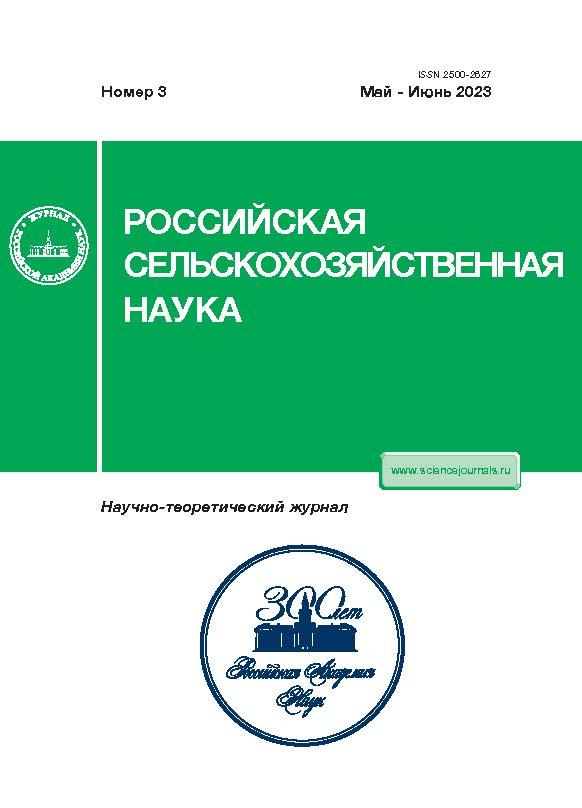Investigation of the complex of phenolic compounds in fruits of the domestic plum (Prunus domestica L.) in conditions of Tambov Region
- 作者: Mironov M.A1, Akimov M.Y.1, Koltsov V.A1, Bogdanov R.E1
-
隶属关系:
- Michurin Federal Scientific Center
- 期: 编号 3 (2023)
- 页面: 25-30
- 栏目: Articles
- URL: https://journals.eco-vector.com/2500-2627/article/view/657845
- DOI: https://doi.org/10.31857/S2500262723030055
- EDN: https://elibrary.ru/EYZERI
- ID: 657845
如何引用文章
详细
作者简介
M. Mironov
Michurin Federal Scientific Center
Email: vniigispr3@yandex.ru
393774, Tambovskaya obl., Michuriinsk, ul. Michurina, 30
M. Akimov
Michurin Federal Scientific Center393774, Tambovskaya obl., Michuriinsk, ul. Michurina, 30
V. Koltsov
Michurin Federal Scientific Center393774, Tambovskaya obl., Michuriinsk, ul. Michurina, 30
R. Bogdanov
Michurin Federal Scientific Center393774, Tambovskaya obl., Michuriinsk, ul. Michurina, 30
参考
- Потребление полифенольных соединений в популяции высокого сердечно-сосудистого риска / Т. И. Батлук, И. П. Березовикова, Д. В. Денисова и др. // Профилактическая медицина. 2020. № 4 (23). С. 67-73. doi: 10.17116/profmed20202304167.
- Федотчева Т. А., Шимановский Н. Л. Фармакологические способы преодоления множественной лекарственной устойчивости к химиотерапии // Химико-фармацевтический журнал. 2022. 56. № 10 (56). С. 3-9. doi: 10.30906/0023-1134-2022-56-10-3-9.
- Extrapolation of phenolic compounds as multi- target agents against cancer and in ammation / N. Kumar, S. Gupta, T. C. Yadav, et al. // Journal of Biomolecular Structure and Dynamics. 2019. Vol. 37 (9). P. 2355-2369. doi: 10.1080/07391102.2018.1481457.
- Агробиологические и морфобиохимические аспекты изучения привойно-подвойных комбинаций сливы / Г. Ю. Упадышева, С. М. Мотылёва, Д. В. Панищева и др. // Садоводство и виноградарство. 2022. № 4. С. 40-47. doi: 10.31676/0235-2591-2022-4-40-47.
- Кочубей А. А., Заремук Р. Ш. Комплексная оценка сортов сливы домашней по качеству плодов в условиях южного садоводства // Аграрная наука. 2019. № 3. С. 62-65.
- Дубровская О. Ю., Жбанова Е. В., Богданов Р. Е. Анализ многолетней динамики содержания химических компонентов плодов сливы // Субтропическое и декоративное садоводство. 2021. № 79. С. 99-107. doi: 10.31360/2225-3068-2021-79-99-107.
- Identi cation, quantitative determination, and antioxidative activities of chlorogenic acid isomers in prune (Prunus domestica L.) / N. Nakatani, S. Kayano, H. Kikuzaki, еt al. // Journal of Agricultural and Food Chemistry. 2000. Vol. 48. P. 5512-5516. doi: 10.1021/jf000422s.
- Chemometric characterization of peach, nectarine and plum cultivars according to fruit phenolic content and antioxidant activity / V. Mitic, M. Ilic, M. Dimitrijevic, еt al. // Fruits. 2016. Vol. 71. P. 57-66. doi: 10.1051/fruits/2015042.
- Trendafilova A., Ivanova V., Trusheva B., еt al. Chemical Composition and Antioxidant Capacity of the Fruits of European Plum Cultivar "Čačanska Lepotica" In uenced by Di erent Rootstocks// Foods. 2022. Vol. 11 (18). URL: https://pubmed.ncbi.nlm.nih.gov/36140977/ (дата обращения: 26.12.2022). doi: 10.3390/foods11182844.
- Identification of phenolic compounds in plum fruits (Prunus salicina L. and Prunus domestica L.) by high-performance liquid chromatography/tandem mass spectrometry and characterization of varieties by quantitative phenolic fingerprints / R. Jaiswal, H. Karaköse, S. Rühmannat, et al. // Journal of Agricultural and Food Chemistry. 2013. Vol. 61 (49). P. 12020-12031. doi: 10.1021/jf402288j.
- Slimestad R., Vangdal E., Brede C. Analysis of phenolic compounds in six Norwegian plum cultivars (Prunus domestica L.) // Journal of Agricultural and Food Chemistry. 2009. Vol. 57. P. 11370-11375. doi: 10.1021/jf902054x.
- Программа и методика сортоизучения плодовых, ягодных и орехоплодных культур / под ред. Е. Н. Седова и Т. П. Огольцовой. Орел: ВНИИСПК, 1999. 606 с.
- Методы анализа минорных биологически активных веществ пищи / под ред. В. А. Тутельяна и К. И. Эллера. М.: Научно-исследовательский институт питания РАМН, Династия, 2010. 180 с.
- Sweet and sour cherry phenolics and their protective e ects on neuronal cells / D.-O. Kim, J. H. Ho, J. K. Young, еt al. // Journal of Agricultural and Food Chemistry. 2005. Vol. 53. P. 9921-9927. doi: 10.1021/jf0518599.
- HPLC Analysis of chlorogenic acid lactones in roasted coffee / C. Bennat, U. H. Engelhardt, A. Kiehne, et al. // Zeitschrift fur Lebensmittel- Untersuchung und Forschung. 1994. Vol. 199. P. 17-21. doi: 10.1007/BF01192945.
- Saygi K. O. Quanti cation of Phenolics from Coriandrum sativum vulgare and Coriandrum sativum microcarpum by HPLC-DAD // Iranian Journal of Science and Technology, Transactions A: Science. 2021. Vol. 45. P. 1319-1326. doi: 10.1007/s40995-021-01132-1.
- Quality assessment of 178 cultivars of plum regarding phenolic, anthocyanin and sugar content / S. Sahamishirazi, J. Moehring, W. Claupein, at al. // Food Chemistry. 2017. Vol. 214. P. 694-701. doi: 10.1016/j.foodchem.2016.07.070.
- Usenik V. The in uence of the production system on the composition of phytochemicals in Prunus domestica L. Fruit // Journal of Food Composition and Analysis. 2021. Vol. 95. URL: https://www.sciencedirect.com/science/article/abs/pii/S088915752031406X (дата обращения: 07.12.2022). doi: 10.1016/j.jfca.2020.103701.
- Characterization of anthocyanins and proanthocyanidins in some cultivars of Ribes, Aronia, and Sambucus and their antioxidant capacity // X. Wu, L. Gu, R. L. Prior, et al. // Journal of Agricultural and Food Chemistry. 2004. Vol. 52. P. 7846-7856. doi: 10.1021/jf0486850.
- Quality changes duringripening of plums (Prunus domestica L.) / V. Usenik, D. Kastelec, R. Veberic, et al. // Food Chemistry.2008. Vol. 111(4). P. 830-836. doi: 10.1016/j.foodchem.2008.04.057.
- Помологические и биохимические особенности плодов сливы / С. М. Мотылева, В. С. Симонов, И. М. Куликов и др. // Вестник российской сельскохозяйственной науки. 2017. № 2. С. 37-42.
- Phytochemical assessment of plum (Prunus domestica L.) cultivars selected in Serbia /j. Tomic, F. Stampar, I. Glisic, et al. // Food Chemistry. 2019. Vol. 30. URL: https://www.sciencedirect.com/science/article/abs/pii/S0308814619312191 (дата обращения: 07.12.2022). doi: 10.1016/j.foodchem.2019.125113.
补充文件








